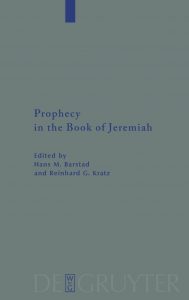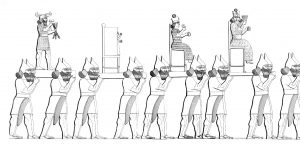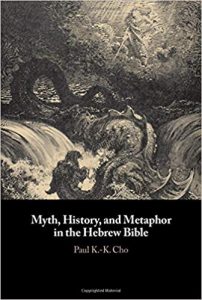Este texto foi publicado pela primeira vez em 1989 e reeditado em 2012. Vale a pena por ser bastante didático na explicação dos novos rumos da pesquisa sobre a literatura profética da Bíblia Hebraica.
Reproduzo aqui dois trechos. O primeiro explica o que é paradigma e porque ocorrem mudanças. O segundo mostra os vários fatores que levam ao enfraquecimento do paradigma dominante e ao aparecimento de um novo paradigma. O autor explica, ao longo do capitulo, que ocupa as páginas 1-18 do livro, como estes fatores aparecem na pesquisa acadêmica sobre o profetismo.
Thomas S. Kuhn, em A estrutura das revoluções científicas (201813), retrata a história das ciências naturais como passando por períodos de “ciência normal” e “revolução”. Um dos conceitos básicos do pensamento de Kuhn é o de “paradigma”, isto é, o complexo de convicções, valores e visão de mundo compartilhado por uma comunidade científica que fornece sua estrutura filosófica para uma pesquisa acadêmica válida, ou qualquer elemento desse complexo relacionado à estratégia, técnica ou método para resolver quebra-cabeças científicos e que é aceito como eficaz e válido nessa comunidade. A ciência normal é, assim, na terminologia de Kuhn, o estágio na história da investigação acadêmica em que os estudiosos de um campo em particular geralmente aceitam a validade de um paradigma de pensamento específico e o aplicam sem questionamentos. O resultado da ciência normal não é tanto a descoberta de algo novo, mas um refinamento e articulação gradual de elementos do paradigma do pensamento e/ou descrição mais precisa de descobertas anteriores obtidas através da aplicação desse modelo.
Esta etapa termina com o advento de uma revolução científica. Uma revolução científica ocorre quando um paradigma dominante de pensamento (ou um elemento desse paradigma) é considerado inadequado e, eventualmente, é abandonado em favor de um novo paradigma a partir do qual procede uma nova visão sobre os problemas envolvidos no campo de estudo. Os estudiosos convencidos da relevância superior do novo conjunto de perguntas e do poder explicativo superior do novo paradigma experimentam uma mudança de paradigma. Uma mudança de paradigma pode, portanto, ser definida como o processo de reconhecer a inadequação e, portanto, o fracasso de uma determinada abordagem acadêmica em fazer perguntas relevantes e/ou sugerir soluções válidas para problemas em um campo acadêmico e que levam à substituição do antigo paradigma de pensamento por uma abordagem mais relevante/válida e/ou promissora. Como essa substituição não implica simplesmente a aplicação de novas técnicas, mas uma mudança completa de perspectiva, também é chamada de conversão – que pode ser um termo ironicamente relevante ao falar sobre profetas.
Na minha opinião, estamos atualmente (pelo menos na minha parte do mundo) em meio a uma mudança de paradigma no que diz respeito à apreciação acadêmica dos profetas do Antigo Testamento em geral e dos chamados “profetas do livro” em particular.
(…)
Sobre o enfraquecimento do paradigma dominante
Nenhum modelo respeitado desaparece subitamente e inexplicavelmente de cena. É primeiro “prejudicado” por uma série de fatores, entre os quais os seguintes são relevantes para nós aqui.
:. Em primeiro lugar, podem surgir novas evidências que não podem ser adequadamente explicadas em termos das suposições do modelo dominante.
:. Em segundo lugar, as suposições do mundo acadêmico podem mudar a tal ponto que as premissas do modelo dominante são seriamente questionadas.
:. Em terceiro lugar, podem surgir novas questões que não podem ser adequadamente pesquisadas e respondidas pelos procedimentos do modelo dominante.
:. Em quarto lugar, os proponentes do modelo dominante podem desaparecer de cena e uma nova geração de estudiosos, formados em circunstâncias diferentes, pode assumir o controle.
Uma vez que tais fatores entram em cena, o modelo reinante é constantemente corroído e se torna cada vez mais questionável até que seja considerado irrelevante – pelo menos por uma parcela da comunidade acadêmica. Enquanto isso, outros modelos começam a competir pela aceitação até que um deles consiga se tornar o modelo dominante em (pelo menos) uma parcela respeitada da comunidade acadêmica.
Kuhn, in his The Structure of Scientific Revolutions (19702), pictures the history of the natural sciences as going through periods of »normal science« and »revolution«. One of the basic concepts in Kuhn’s thought is that of »paradigm«, i. e. the complex of convictions, values, and world view shared by a scientific community which provides its philosophical framework for valid academic inquiry, or any element of such a complex that has to do with the strategy, technique, or method for solving scientific puzzles and that is accepted as effective and valid within that community. Normal science, then, in Kuhn’s terminology, is that stage in the history of academic ![FRITZ, V. et al. (eds.) Prophet und Prophetenbuch: Festschrift für Otto Kaiser zum 65. Geburtstag. Berlin: Walter de Gruyter, [1989] 2012 FRITZ, V. et al. (eds.) Prophet und Prophetenbuch: Festschrift für Otto Kaiser zum 65. Geburtstag. Berlin: Walter de Gruyter, [1989] 2012](https://airtonjo.com/blog1/wp-content/uploads/2019/09/volkmarfritz-2-189x300.jpg) inquiry at which scholars in a particular field generally accept the validity of a particular paradigm of thought and apply it unquestioningly. The outcome of normal science is not so much the discovery of something new as a gradual refinement and articulation of elements of the paradigm of thought and/or more precise description of previous findings obtained through the application of that model.
inquiry at which scholars in a particular field generally accept the validity of a particular paradigm of thought and apply it unquestioningly. The outcome of normal science is not so much the discovery of something new as a gradual refinement and articulation of elements of the paradigm of thought and/or more precise description of previous findings obtained through the application of that model.
This stage ends with the advent of a scientific revolution. A scientific revolution occurs when a dominant paradigm of thought (or an element of such a paradigm) is found to be inadequate and is eventually abandoned in favour of a new paradigm from which proceeds a new view on the problems involved in the field of study. Scholars convinced of the superior relevancy of the new set of questions and of the superior explanatory power of the new paradigm then experience a paradigm switch. A paradigm switch can thus be defined as the process of acknowledging the inadequacy and, therefore, the failure of a given academic approach to ask relevant questions and/or suggest valid solutions to problems in an academic field and that leads to the replacement of the old paradigm of thought by a more relevant/valid and/or promising approach. Since such a replacement does not simply imply the application of new techniques, but a complete change in outlook, it is also called a conversion — which may be an ironically relevant term when speaking about the prophets.
To my mind we are at present (at least in my part of the world) in the midst of such a paradigm switch with regard to the scholarly appreciation of the Old Testament prophets in general and the so-called »writing prophets« in particular.
(…)
The undermining of the dominant paradigm
No respected model suddenly and inexplicably disappears from the scene. It is first »undermined« by a number of factors, among which the following are relevant to us here. Firstly, new evidence may come to light which cannot be adequately explained in terms of the assumptions of the dominant model. Secondly, the assumptions of the scholarly world may change to such an extent that the premisses of the dominant model are seriously called in question. Thirdly, certain new questions may arise which cannot be adequately researched and answered by the procedures of the dominant model. Fourthly, the proponents of the dominant model may disappear from the scene and a new generation of scholars (that grew up under different circumstances) may take over.
Once such factors come into play the reigning model is steadily eroded and becomes more and more questionable until such time as it is experienced as irrelevant – at least by a section of the scholarly community. In the meantime other models start competing for acceptance until one of them succeeds in becoming the dominant model within (at least) a respected section of the scholarly community.
Trecho de DEIST, F. E. The prophets: are we heading for a paradigm switch? In: FRITZ, V. et al. (eds.) Prophet und Prophetenbuch: Festschrift für Otto Kaiser zum 65. Geburtstag. Berlin: Walter de Gruyter, [1989] 2012, p. 1 e 5.




